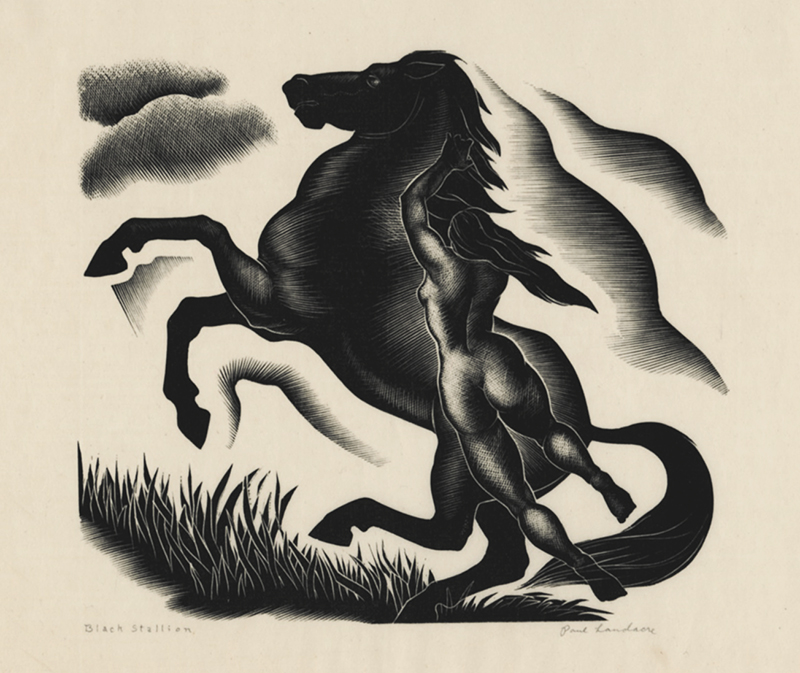Black Stallion is a wood-engraving created in 1940 by American printmaker Paul Landacre (1893-1963). It is pencil signed and titled and was published in an edition of 200 by the Woodcut Society. It was printed on a soft ivory Japanese hosho and the image measures 6 x 7 inches. References are Wien 236, Woodcut Society Presentation Print 17, and Library of Congress 1.
Black Stallion is one of four wood-engravings Landacre created in 1940. In his image, Landacre idealizes the raw strength and beauty of both the horse and the female body. Movement is suggested by the rearing of the stallion which lifts the woman off the ground and by the flowing manes of both. In writing a recommendation for Landacre for a Guggenheim Foundation grant, Merle Armitage declared: It is my considered opinion that he is the greatest technician of his type who is working today. He is a complete master of the intricacies of wood-engraving, and his work from a technical side is impeccable.
Paul Landacre was born in July 1893 in Columbus, Ohio and attended Ohio State University until he was suddenly crippled by a debilitating illness. In 1916, he moved to Chula Vista, California to convalesce and he found solace in drawing the landscape and purchased his first linoleum blocks. He moved to Los Angeles in 1922 to attend classes at the Otis Art Institute. Woodengraving was not part of the curriculum so he was self-taught. He worked as a commercial illustrator, married Margaret McCreery in 1925, and devoted himself to woodengraving in 1926.
He taught at the University of Southern California, the Otis Art Institute and the Kahn Institute and was a member of and exhibited with the California Society of Etchers, the California Print Makers Society, the American Society of Wood Engravers, and the American Society of Etchers. Landacre became the pre-eminent American woodengraver, an honor bestowed by Rockwell Kent and Carl Zigrosser. His mastery of the medium led to his election to the National Academy of Design in 1946. Landacre illustrated award winning books of poems and his first solo book, California Hills and other Woodengravings of 1931 won Fifty Books of the Year.
Paul Landacre’s work is represented in the collections of the Boston Museum of Fine Arts; the Library of Congress and the National Museum, Washington, D.C.; the Los Angeles Public Library; the Museum of Modern Art, New York; the Oakland Museum of California Art; the New York Public Library; the Philadelphia Museum; the Terra Foundation for American Art, Chicago; the Fine Arts Museums of San Francisco; and the Seattle Museum. Landacre’s nineteenth century Washington Hand Press is now in the collection of the International Printing Museum in Carson, California.
Paul Landacre died in Los Angeles, California in 1963.



